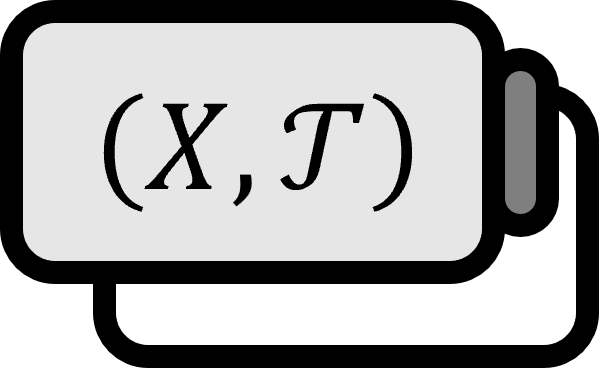Cantor Set
Definition

Let $$ \begin{align*} I =& \left[ 0, 1 \right] \\ C_{1} =& \left[ 0, {{1} \over {3}} \right] \cup \left[ {{2} \over {3}} , 1 \right] \\ C_{2} =& \left[ 0, {{1} \over {3^2}} \right] \cup \left[ {{2} \over {3^2}}, {{3} \over {3^2}} \right] \cup \left[ {{6} \over {3^2}}, {{7} \over {3^2}} \right] \cup \left[ {{8} \over {3^2}} , 1 \right] \\ &\vdots \\ C_{n} =& \left[ 0, {{1} \over {3^n}} \right] \cup \left[ {{2} \over {3^n}}, {{3} \over {3^n}} \right] \cup \cdots \cup \left[ {{3^n-3} \over {3^n}}, {{3^n-2} \over {3^n}} \right] \cup \left[ {{3^n - 1} \over {3^n}} , 1 \right] \end{align*} $$.
$\displaystyle C := \bigcap_{n=1}^{\infty} C_{n}$ is called the Cantor Set.
Theorem
- [1]: $C = \left\{ x \in I \ | \ x= 0.x_{1} x_{2} \cdots , x_{i} \in \left\{ 0,2 \right\} \right\}$
- [2]: $C$ is an uncountable set.
Explanation
The Cantor set is defined simply but appears as an important example in real analysis.
Theorem [1] means that every element of the Cantor set can be expressed using only $0$ and $2$ in its ternary expansion. No need to prove it specifically, but if you think about it, it isn’t too hard to understand.
Moreover, adding up the lengths of all intervals results in $\displaystyle \lim_{n \to \infty} \left( {{2} \over {3}} \right)^{n} = 0$, which is quite interesting because it is an uncountable set. This uncountability is usually proven by applying Cantor’s diagonal argument to theorem [1], showing that there is no one-to-one correspondence between $C$ and the set of natural numbers using ternary representation, which doesn’t provide much learning in the process.
I’ve summarized a more topology-oriented proof for reference.
Proof
[2]
Part 1.
It is trivially true that $C \subset \mathbb{R}$, thus it can be a metric space. Since $C$ is defined as an intersection of closed intervals, it is a closed set.
Heine-Borel Theorem: For $E \subset \mathbb{R}^{n}$, a necessary and sufficient condition for $E$ to be compact is that $E$ is bounded and closed.
Meanwhile, since $C \subset [0,1]$, it is bounded, and by the Heine-Borel theorem, $C$ is a compact space. Being compact in a metric space is equivalent to being complete and totally bounded, hence, $C$ is a complete metric space.
Baire Category Theorem: Every complete metric space is a Baire space.
By the Baire category theorem, $C$ is a Baire space.
Part 2.
For any $c \in C$ and $\varepsilon>0$, $B(c, \varepsilon )$ contains at least one point that is not $c$.
This is described as $C$ having no isolated points, which is mathematically expressed as $$ \left( C \setminus \left\{ c \right\} \right) \cap B(c, \varepsilon ) \ne \emptyset $$ Therefore, removing just one point from the whole, $C \setminus \left\{ c \right\}$ is a dense set in $C$.
Part 3.
Assuming that $C$ is a countable set, it could be represented by $C = \left\{ c_{n} \ | \ n \in \mathbb{N} \right\}$.
Definition of a Baire space: For every dense open set sequence $\left\{ O_{n} \right\}_{n=1}^{\infty}$, $\displaystyle \bigcap_{n=1}^{\infty} O_{n}$ makes the space a Baire space if it is dense.
Since Part 1 showed that $C$ is a Baire space and Part 2 showed that $C \setminus \left\{ c_{n} \right\}$ is a dense set, $\displaystyle \bigcap_{n=1}^{\infty} \left( C \setminus \left\{ c_{n} \right\} \right)$ is dense. However, $\displaystyle \bigcap_{n=1}^{\infty} \left( C \setminus \left\{ c_{n} \right\} \right) = \emptyset$ and $\overline{ \emptyset } \ne C$, so it is not a dense set. This contradiction means that $C$ is an uncountable set.
■
